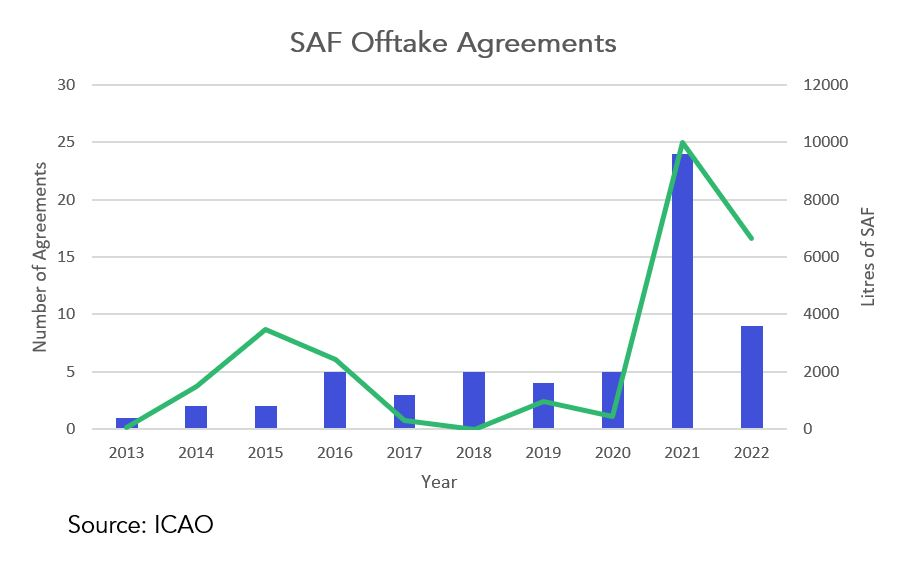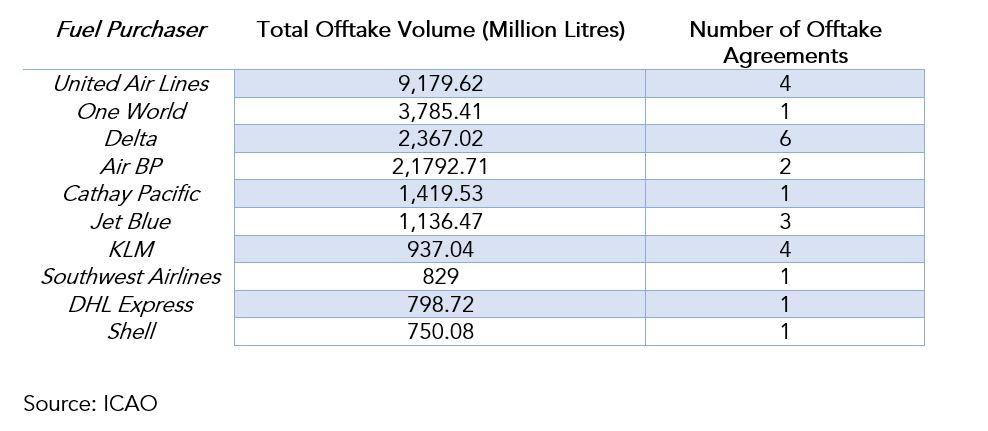28/04/2022
IBA's Tim Boon looks at the ramp up in Sustainable Aviation Fuel offtake agreements since 2013.
Sustainable Aviation Fuel ‘SAF' is currently one of the leading solutions to reducing CO2 intensity from the commercial aviation industry. Whilst there are other means of emissions abatement being deployed (such as new technology aircraft powered by hydrogen, electric or hybrid aircraft) the reliance on a paradigm shift for new infrastructure and supply chain shift towards new technology means that there is still a long way to go before the industry can truly transition to different fuel sources.
Airlines first entered offtake agreements with SAF producers in 2013, when major US carrier United Airlines agreed to take 56.8 million litres of SAF from World Energy over a three-year period. Since then, there has been a significant shift in the market, with key industry players deploying significant capital into offtake agreements and investments in SAF refineries and carbon capture facilities.
There were 27 offtake agreements signed between 2013 and 2020, totalling 9,170 million litres of SAF. Following this in 2021 and 2022 were a combined a total of 33 offtake agreements totalling 16,630.72 million litres of SAF. The offtake periods vary from anywhere between 1 year and 20 years. IBA's analysis indicates the cost of SAF per US Gallon ranges from $4 USD to $8 USD, depending on the length of the agreement and quantity of fuel being provided.

Major airlines generally have offtake agreements with a range of different suppliers in order to leverage as many stakeholders in the SAF production industry. This helps to ensure enough feedstock is available to suit their needs. Delta Air Lines has a total of six offtake agreements with a total of 3,367 million litres of fuel, with KLM and American Airlines currently having a total of hour outstanding offtake agreements. Aviation intelligence from IBA Insight reveals Virgin Atlantic's fuel requirements from London Heathrow (LHR) totalled around 255 million litres of Jet-A1 in 2021. With the addition of the 2.5 million litres promised by ExxonMobil, this will contribute to around 1% of their fuel usage based on similar utilisation in 2022. With the usage of the SAF as supplied by ExxonMobil, Virgin Atlantic can expect to see their emissions reduce on a lifecycle basis by 0.9% across their London Heathrow operations. This will result in a projected total of 805,000 tonnes of CO2 produced by their operations at London Heathrow Airport.
As SAF mandates begin at 2% for aircraft departing European airports in 2025, the requirements to scale up production will only become more prominent.

Current infrastructure at most major airports makes it extremely challenging to accurately measure the amount of SAF delivered to a particular flight without the use of a fuel bowser. This is due to most of the major hub airports' use of fuel farms and fuel hydrant systems to deliver fuel. Fuel is typically delivered to these airports through pipelines, rail and road. Regardless of this, the kerosene at airport fuel farms will generally be mixed at the fuel farm which, will include stocks from various fuel suppliers. The main delivery for blended SAF to aircraft is currently through fuel trucks supplied by the fuel producer.
Looking further ahead, IBA anticipates a minimum of 2% SAF will be pre-blended at the refinery for European operations to ensure the seamless policing of the 2025 mandate.
IBA's Carbon Emissions Calculator, part of IBA Insight, is regularly updated to give our users the most diverse aviation intelligence and insight on aviation carbon emissions.
関連コンテンツ
British Airways has taken delivery of UK-made Sustainable Aviation Fuel from Phillips 66 Limited